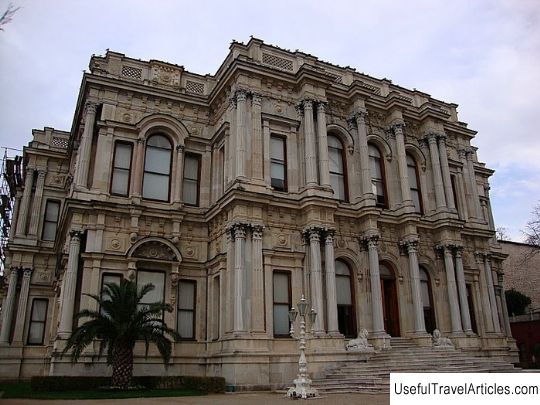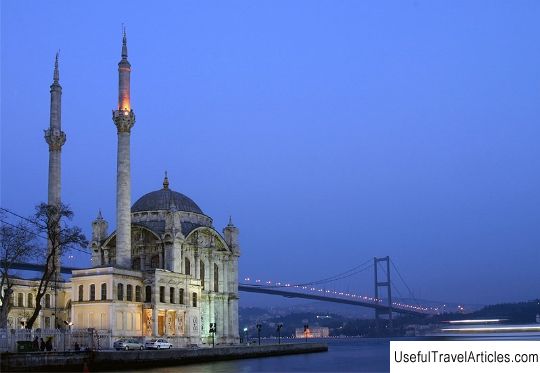Beylerbeyi Sarayi palace description and photos - Turkey: Istanbul
Rating: 8,4/10 (8695 votes) 
Beylerbeyi Sarayi description and photos - Turkey: Istanbul. Detailed information about the attraction. Description, photographs and a map showing the nearest significant objects. The title in English is Beylerbeyi Sarayi. Photo and descriptionSince the time of the Byzantine Empire, the territory of the modern district of Istanbul - Beylerbey, located on the Asian coast of the Bosphorus, has been inhabited. Historical sources of the 18th century tell us that this place got the name "Istavroz Gardens" (from Byzantine, istavroz - cross) after Emperor Constantine the Great erected a cross here. During the Ottoman era, there was an imperial park here. Injijian, a famous traveler of the 16th century, describes the events in which this place was named Beylerbeyi. During the reign of Murad III, in the 16th century, Mehmed Pasha was awarded the title of Governor-General - Beylerbey of Rumelia, after which he built a country house on the banks of the Bosphorus. By order of Sultan Mahmud II in 1827 in Beylerbey appeared a palace, which was created by the architect Kirkor Balyan. However, in 1851, during the reign of Sultan Abdul-Majid I, this structure, consisting entirely of wood and adjacent to the coast, was partially destroyed by fire. Only the Mermer Koshk Marble Pavilion, a large pool and a lower terrace managed to survive. Ottoman sultans in the 17th century built summer residences and pavilions here. In 1861-1864, by order of the padishah Abdulaziz - the brother and heir of Abdul-Majid I, at the same place where the wooden palace belonging to Mahmud II was destroyed by fire, the architects Agop and Sarkis Balyan re-erected a new palace - a summer residence sultans. It served as a place of accommodation for important guests of foreign states during their visit to the Ottoman capital and was made in the Baroque style. In 1865. the construction of the structure of stone and white marble was completed. Its length along the coast is 65 m. It was surrounded by magnolia gardens. The palace was divided into two parts - a harem and common rooms. Beylerbey consisted of two main floors and a basement (basement) room, which housed the kitchen and storerooms. The palace was beautifully and tastefully decorated, it has three entrances, 6 large ceremonial halls and 26 rooms. Behind it are flower beds with fragrant magnolias. There is also a large swimming pool and several summer palaces. The interior of the palace is a whimsical mixture of a variety of Eastern and Western styles, although the layout of the rooms itself is in Turkish tradition with a sofa in the middle. The furnishings and decoration of the harem, in comparison with the common chambers, looked more modest. The decoration and decoration of public rooms called Selamlyk was richer and more varied. It is interesting that the floor in Beylerbeyi was covered with reeds supplied from Egypt (the so-called Egyptian mats). In winter, he saved the inhabitants from dampness and moisture, and in summer he was a salvation from the heat. Rare handmade carpets were laid on the floor. The same carpets were in the Dolmabahce Palace. They were made in the palace weaving workshops in Herek. In the palace you can admire the magnificent beauty of Bohemian crystal chandeliers, Chinese, Japanese, French and Turkish porcelain vases, as well as French clocks. Sultan Abdulaziz was passionate about ships. During his reign, the Turkish fleet was the second largest in the world after the English. This was reflected in the interior decoration of the palace. Here you can observe a large variety of marine motifs and images of ships. Around the palace there were hunting grounds, a zoo and a garden with plants brought here from all over the world. There is a tunnel leading from the palace to the gardens, built under Mahmud II. This is unusual for a palace like this. usually bridges were built for this. The Yellow and Marble Pavilions, the Musical Apartments, the Deer House, the Pigeon Temple, the bird yard and the royal stables surround the palace. At different times such important persons as the Prince of Wales, King Edward VIII, and the Austrian Emperor Franz Joseph visited here , Prince Nikolay, Persian Shah Nasreddin, King of Montenegro, Prince of Serbia, the last Sultan of Turkey Abdulhamid. Shah of Iran - Nasruddin after the overthrow was imprisoned in this palace and died here in 1918. And in 1869, the wife of Napoleon III, Empress Eugenia, also stayed in the palace. Sultan Abdulaziz himself supervised the process of preparing and decorating the rooms of such an important guest. It was said that he was very partial to the Empress. This is evidenced by the fact that even the mosquito net that hung on the window above Eugenia's bed was studded with the smallest pearls. The French empress was so flattered that when she returned home, she ordered the same windows for her Tuileries palace as in the Beylerbey residence on the Bosphorus coast.         We also recommend reading The Faceted Chamber in the Kremlin description and photo - Russia - Moscow: Moscow Topic: Beylerbeyi Sarayi palace description and photos - Turkey: Istanbul. |




